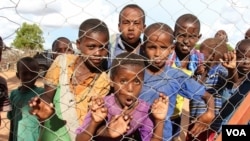The U.N. High Commissioner for Refugees Antonio Guterres is in Kenya this week to discuss security and voluntary repatriation from the world’s largest refugee camp, Dadaab, which the Kenyan government has threatened to close.
The fate of hundreds of thousands of Somali refugees could hang in the balance.
Ever since al-Shabab gunmen massacred 148 people at Garissa University last month, the attention of the Kenyan government has been focused on the world’s largest refugee camp, Dadaab.
On April 11 Kenyan Deputy President William Ruto issued an ultimatum to the United Nations – close the camps within 90 days, he said, or we will do it for you.
Guterres met with Kenyan President Uhuru Kenyatta on Wednesday, and said he was assured that the 350,000 refugees in Dadaab would not, in fact, be forcibly sent back.
“The government of Kenya has already clarified that return would take place in the context of the Tripartite Agreement, and the Tripartite Agreement is an agreement for voluntary repatriation of Somali refugees, in safety and dignity, to their country. There was a clear assurance that this will be the case," said Guterres.
But he also made it clear that UNHCR was redoubling its efforts to make it possible for the refugees to go home. The U.N.’s voluntary resettlement program would be enhanced, he said, and more districts in Somalia would be approved to receive returnees.
“I want to reassure the government of Kenya that we will be doing everything we can in order to create the conditions for this program of voluntary repatriation of Somalis, in safety and dignity, to be successful, to be sustainable, and to be meaningful. This is, for UNHCR, now one of our global priorities," Guterres said.
The most recent threat to close Dadaab, coming as it did from such a powerful figure as Ruto, has alarmed the international community. But Andrew Maina of the Refugee Consortium of Kenya says the message has been the same for years.
“The message that has constantly been given to UNHCR from the Kenyan government is that we are tired of hosting these people," he said. "Find a durable solution; just get them out, one way or another."
During his visit the high commissioner also discussed security within Dadaab, which Kenyan officials have claimed is a haven for terrorists.
Guterres acknowledged that security in the camp needs to be strengthened. But Maina says the connection between Dadaab and terrorism itself is difficult to prove.
“The major problem with that is the lack of clear evidence between hosting refugees and terrorism and insecurity in the country," he said. "So this connection between the two is a bit disingenuous, and it’s not really taking into account to wider issues of terrorism and counter-terrorism strategies in this country."
What is certain is that al-Shabab still poses a major threat within Somalia, and at the moment there are few structures in place to accommodate new arrivals.
One Somali refugee in Nairobi says there are no homes for returnees, no health care and no schools. And without education, he adds, young people will likely join one of the only groups that can pay them: al-Shabab.
Guterres said significant investment was needed to create the conditions that will make refugees want to return, and will give them something to return to. This, he said, includes improving security, but also building functional public services.
But it will require significant investment on the part of the international community, he added, to make any sort of large-scale return of Somali refugees possible.









